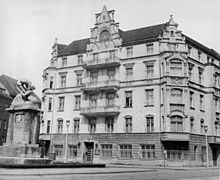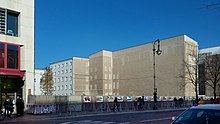Polish Embassy in Berlin
|
|||
|---|---|---|---|
| State level | bilateral | ||
| Position of the authority | Embassy | ||
| Supervisory authority (s) | Foreign Ministry | ||
| Consist | since 1918 | ||
| Headquarters |
|
||
| ambassador | Andrzej Przyłębski | ||
| Employee | 38 | ||
| Website | berlin.msz.gov.pl/de | ||

The Embassy of the Republic of Poland in the Federal Republic of Germany ( Polish Ambasada Rzeczypospolitej Polskiej w Republice Federalnej Niemiec ) is the diplomatic representation of the Republic of Poland in the Federal Republic of Germany .
The building currently in use (the former Polish military mission) is located in the Berlin district of Grunewald in the Charlottenburg-Wilmersdorf district . Until 1994, the Berlin headquarters of the embassy was on the boulevard Unter den Linden 70–72 and is to be rebuilt at this point.
history
Polish representation until World War II

As a result of the Polish partitions , Poland had no state sovereignty between 1795 and 1918, and therefore no diplomatic missions. After all of the three partitioning powers lost the First World War in 1917 and 1918 or sank into the chaos of revolution, Poland regained its sovereignty with the Treaty of Versailles as the Second Polish Republic . The newly formed Polish Legation Office in Berlin now resided at Kurfürstenstrasse 136 in the Schöneberg district of Berlin , the consulate directly next to it at Kurfürstenstrasse 137 on the corner of Motzstrasse (or between 1934 and 1998 Mackensenstrasse , today: Else-Lasker-Schüler-Strasse). The Polish envoy in Berlin at the time of the " seizure of power " was Alfred Wysocki , who in 1933 moved to Rome as envoy . He was replaced on October 18, 1933 by Józef Lipski (later appointed ambassador), who held the post until the war against Poland in 1939.
After the defeat of Poland in 1939 and the establishment of the General Government and the incorporation of parts of Poland into the German Reich and the Soviet Union, the German Reich confiscated the buildings on Kurfürstenstrasse and used them for the German Information Center, a propaganda department of the Foreign Office under Joachim von Ribbentrop in Foundation form. The Generalgouvernement under Hans Frank was directly subordinate to Adolf Hitler , and therefore had no diplomatic representation in Berlin.
Polish military mission
After the end of the Second World War , Poland set up a military mission in Berlin in 1945 that was accredited by the Allied High Commission . The Polish military mission was based in the Berlin district of Grunewald at Lassenstrasse 19-21. In 1946, the publicist Marcel Reich-Ranicki worked there for a few months in a rather subordinate position.
In May 1957, Władysław Tykociński , previously head of cabinet in the Polish Foreign Ministry, took over the management of the Polish military mission in West Berlin . After seven years, Tykociński left his post under spectacular circumstances, deferring to the Americans on May 16, 1965. In interviews he then made statements about the intelligence service's use of the military mission, for which he was sentenced to death in absentia in Warsaw in 1966. Among other things, he testified that from the mid-1960s onwards, around 50 members of the military mission performed almost 40 intelligence tasks, mainly for the Polish Security Agency (UB).
Embassy building in the GDR era
After the Prime Minister of the GDR , Otto Grotewohl , announced in his first government declaration on October 12, 1949, that the GDR finally recognized Poland's western border, Poland recognized the GDR on October 18, 1949 and established diplomatic relations with it. The People's Republic of Poland first moved into a tenement house built in 1830 at Luisenstrasse 13-14, and later a building at Berliner Strasse 120 in the Pankow district . Since February 1967 she resided in a new building on Unter den Linden 70-72, which was adapted to the existing historical buildings in the eaves height because the earlier buildings at this point had been destroyed at the end of the Second World War. The steel frame construction with a curtain metal and glass facade as well as colored parapet fields below the windows on the upper floors was designed by the architect collective Emil Leybold and Christian Seyfarth.

224 sheets of steel, designed and executed by the metal artist Fritz Kühn , adorned the entrance to the embassy. As a highlight , the decorative relief received a small bird that has perched on a linden leaf. The folded metal circles with etched stylized linden leaves made a reference to the street. The five-story building was a listed building .
Temporary embassy in Grunewald

With German reunification , the formation of the Third Polish Republic from 1989 and the decision soon thereafter to move the German government from Bonn to Berlin ( Berlin / Bonn Law ) - until now the Polish Embassy was in the former Villa Heinrich Neuerburg in the Cologne district Marienburg resident - the Polish state planned to build a new building on the grounds of Unter den Linden 70-72 and in 1998 announced an architectural competition. The victorious ideas of the Polish architects Budzyński, Badowski and Kowalewski envisaged cladding the existing steel frame with new natural stone and copper facade elements and closing the building with a copper roof. A multi-storey garden courtyard was planned in the building depth. From 1994 the house in Berlin-Mitte was vacated and the ambassador and his staff moved to an alternative quarter in a villa in the Grunewald district . However, the new building project was only approved by the Senate Building Administration after three revisions, after which the street front with a sandstone perforated facade and the application of name reliefs of famous Poles as well as glass windows and a structure with copper panels instead of a closed ground floor. On January 27, 2004, however, the Polish government announced that it was foregoing a new building for no reason and instead wanted to renovate the monument and then use it again as the embassy headquarters. However, the work hardly progressed and was halted by new decisions (see below).
The temporary quarters are located in a villa in Berlin-Grunewald (Lassenstrasse 19–21), formerly the seat of the Polish Military Mission. The consular department of the embassy is located in the neighborhood (Richard-Strauss-Straße 11).
The built-up area in Cologne owned by the Polish state, previously used as a consulate general, has been for sale since 2014.
Concrete steps for a new building on Unter den Linden
In November 2012 the Polish government decided to build its embassy in Berlin. The new building initially requires the demolition of the vacant house described above, for which the Berlin Senate granted approval despite the fact that it was still under monument protection. The concept by JEMS Architekci from Warsaw emerged as the winner of a new competition in 2012. It provides for a five-storey building complex with two inner courtyards and an atrium in the part of the building on Unter den Linden. A light facade and large windows define the street view. The demolition and the subsequent start of construction were planned for 2013, the completion planned for 2016. The previous building was only demolished in autumn 2016. According to Jacek Biegala, Counselor of the Embassy, the Polish Cultural Institute, which was previously located on Hackescher Markt, will move into the complex . There will be exhibition space behind large windows on the ground floor of the new building. The estimated cost is at least 40 million euros. The house then offers space for all 60 embassy employees. The villa in Grunewald will then be converted into the residence of the Polish ambassador.
Embassy work and structure
The embassy maintains the following departments, each headed by an attaché :
- Politics,
- Public relation,
- Press,
- Defense ,
- Economy,
- Trade and investment and
- Consular affairs.
The area of responsibility includes the official mutual agreements, the exchange of delegations in the various areas, the support of the Polish citizens living in Germany, the coordination of the activities of the three Polish institutes in Germany: Berlin-Mitte (Burgstrasse 27; am Hackescher Markt ), Düsseldorf ( Citadellstrasse 7 ) and Leipzig (Markt 10) and much more. In March 2010 there were ten members of the embassy.
See also
Web links
Individual evidence
- ↑ authorities . In: Berliner Adreßbuch , 1922, part 3, p. 6.
- ^ Kurfürstenstrasse . In: Berliner Adreßbuch , 1938, part 4, Schöneberg, p. 1559.
- ↑ Mackensenstrasse . In: Street name lexicon of the Luisenstädtischer Bildungsverein
- ^ Alfred Kube: Pour le Mérite and swastika . Oldenbourg, Munich 1987, ISBN 978-3-486-53122-0 , p. 104.
- ^ Kurfürstenstrasse 136 . In: Berliner Adreßbuch , 1941, part 4, Schöneberg, p. 1572.
- ↑ Peter Longerich: Propagandists in War. The press department of the Foreign Office under Ribbentrop . Oldenbourg, Munich 1987, ISBN 3-486-54111-0 , p. 52.
- ↑ Wladyslaw Tykocinski . In: Der Spiegel . No. 21 , 1957 ( online ).
- ↑ Mission finished . In: Der Spiegel . No. 22 , 1965 ( online ).
- ↑ Testimony of Wladyslaw Tykocinski . Hearing, Eighty-Ninth Congress, Second Session. April 6, 1966. United States Government Printing Office , Washington 1966.
- ↑ Architectural monument tenement on Karlsplatz
- ↑ Messages . In: Telephone book for the capital of the GDR , 1965, p. 51.
- ^ Polish Embassy Unter den Linden . In: Neues Deutschland , February 19, 1967, p. 2.
- ↑ Monument Polish Embassy UdL 70–72
- ↑ Thought differently. New message is not being built . At: baunetz.de , January 28, 2004; accessed March 23, 2010
- ^ Unrestricted public tender for the sale of a property in Cologne-Marienburg ; accessed on March 27, 2015.
- ^ Uwe Aulich: Diplomacy with culture. Poland wants to build a new embassy on Unter den Linden by 2016. We have also thought of large exhibition areas . In: Berliner Zeitung , November 29, 2012, p. 21
- ↑ Der Tagesspiegel, New Home for Poland in Berlin: October 7, 2018
- ^ Homepage of the Polish Trade and Investment Department. Embassy, Berlin, Leipziger Platz
- ↑ Polish homepage. Inst. In Berlin
- ↑ Polish homepage. Inst. In Düsseldorf
- ↑ Polish homepage. Inst. In Leipzig
Coordinates: 52 ° 31 ′ 0.8 ″ N , 13 ° 22 ′ 56.1 ″ E



